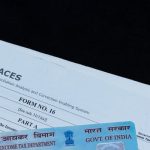Form 26AS – How to View and Download Form 26AS Online?
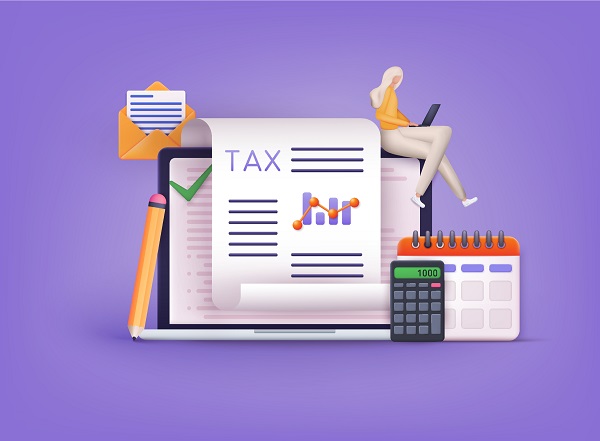
What is Form 26AS?
Form 26AS is a consolidated tax statement issued by the Income Tax Department of India containing the details of all tax deducted on behalf of a taxpayer and taxes paid by the taxpayer during a financial year. This form is also known as Annual Statement or Tax Credit Statement.
Form 26AS includes information about tax deducted at source (TDS) on salary, interest income, and other payments, as well as tax collected at source (TCS) and advance tax payments made by the taxpayer. The form also contains information about refunds received, if any, and details of high-value transactions reported by the taxpayer during the financial year.
It is important for taxpayers to verify the information in Form 26AS with their own records to ensure that all taxes have been accurately credited to their account. Looking for Form 26AS download option? Scroll to the next section to understand!
What’s New in Form 26AS?
As a part of a recent update, Form 26AS would show only Tax Deducted at Source (TDS) and Tax Collected at Source (TCS). All other information pertaining to advance tax, self-assessment tax and refunds would reflect on Annual Information Statement (AIS).
How to Download Form 26AS?
There are two ways through which you can download Form 26AS online. You can use the TRACES portal to download Form 26AS. Alternatively, you can avail the net banking facility of authorised banks.
Follow the steps below to understand Form 26AS download process via TRACES portal:
- Go to the e-filing Portal
Visit the official e-filing portal and log in using your credentials

- Enter Your User ID
Your user ID could be either Aadhaar or PAN
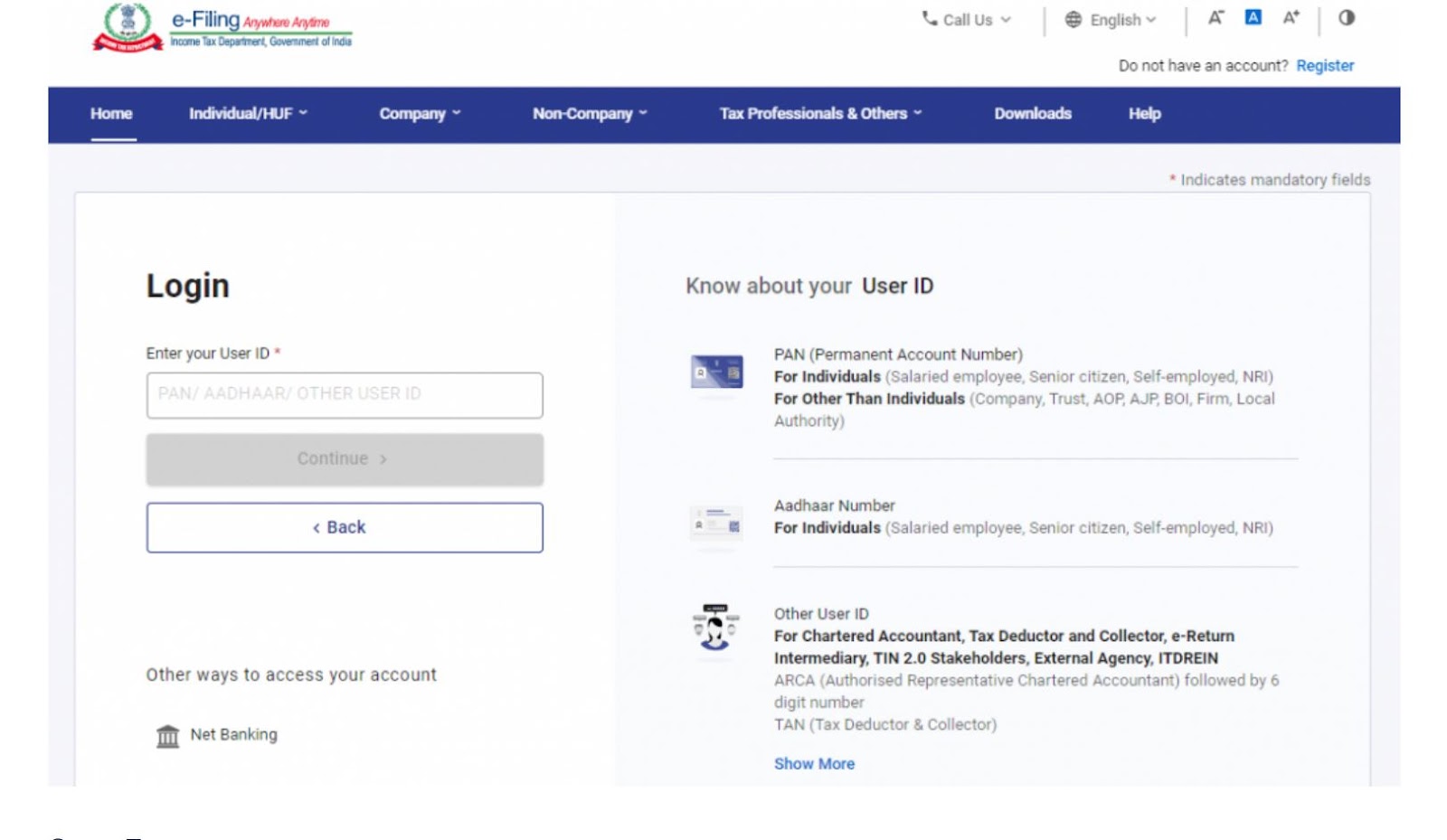
- Confirm Secure Access Message
Select the checkbox below to confirm the secure access message. Enter the password and continue.
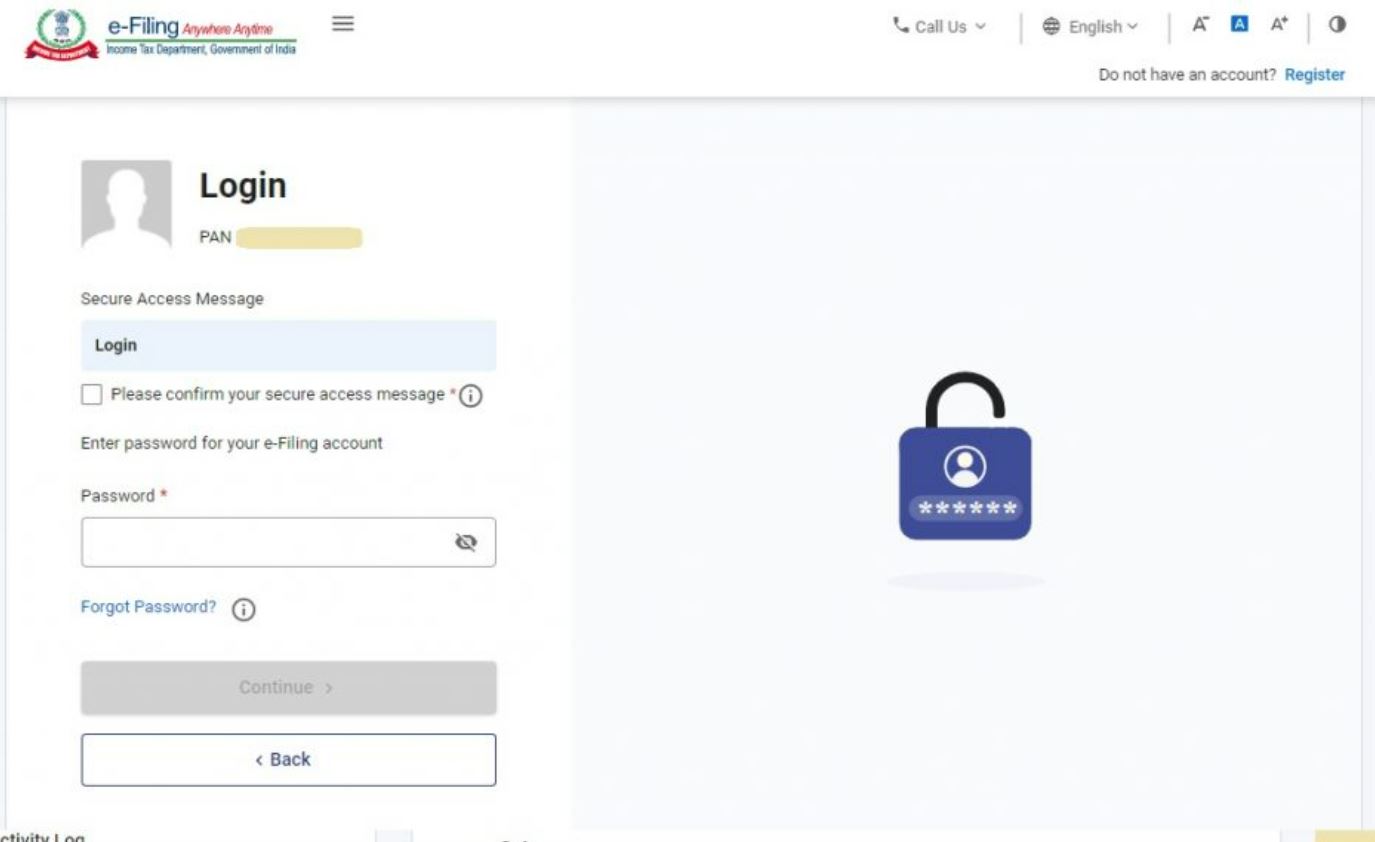
- Go to e-File
Go to ‘e-file’. Click on ‘Income Tax Returns’ and select ‘View Form 26AS’ from the dropdown menu.
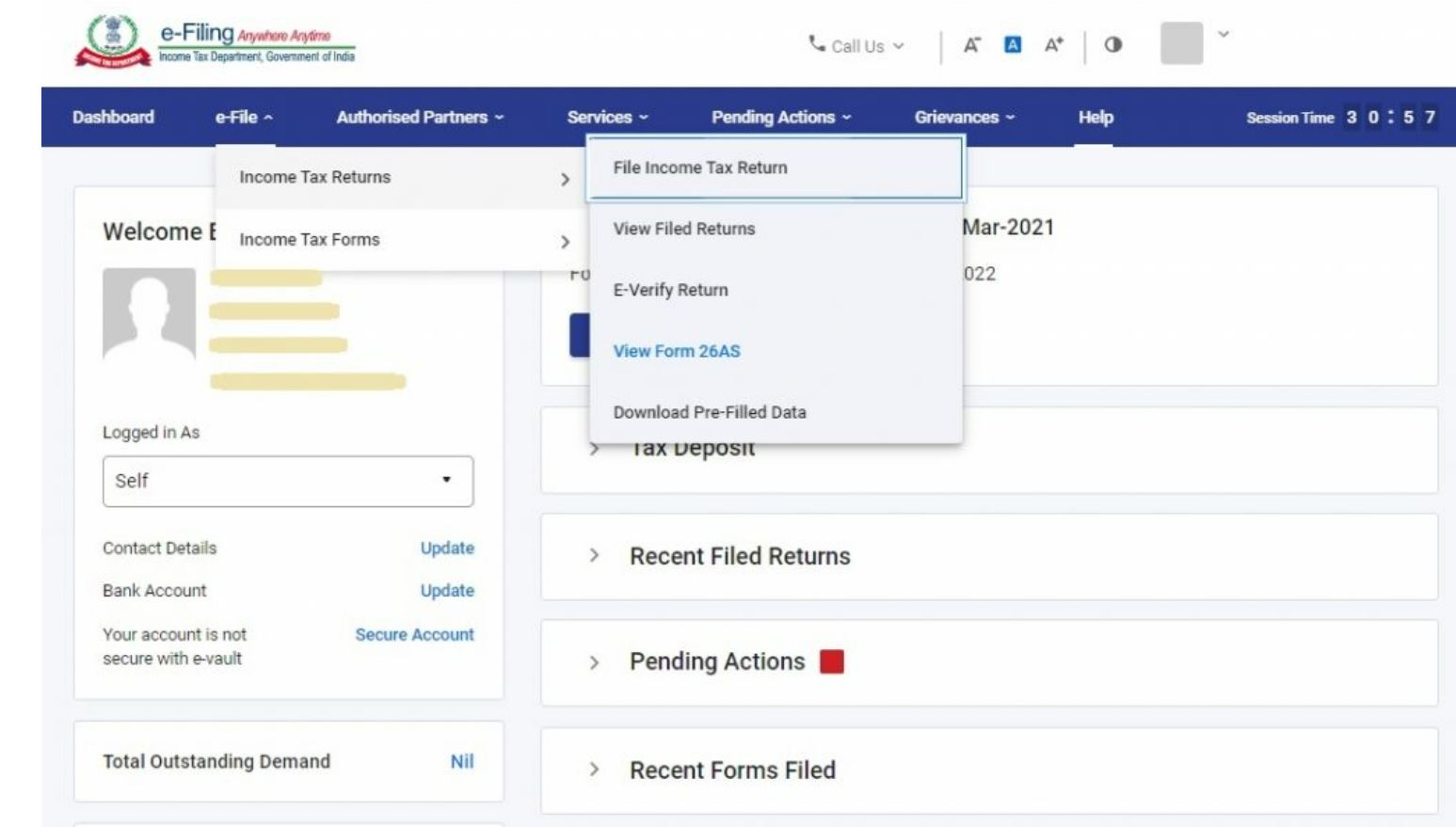
- Click ‘Confirm’
You will be able to check the Disclaimer page. Click ‘Confirm’ to access the TRACES (TDS-CPC) website.
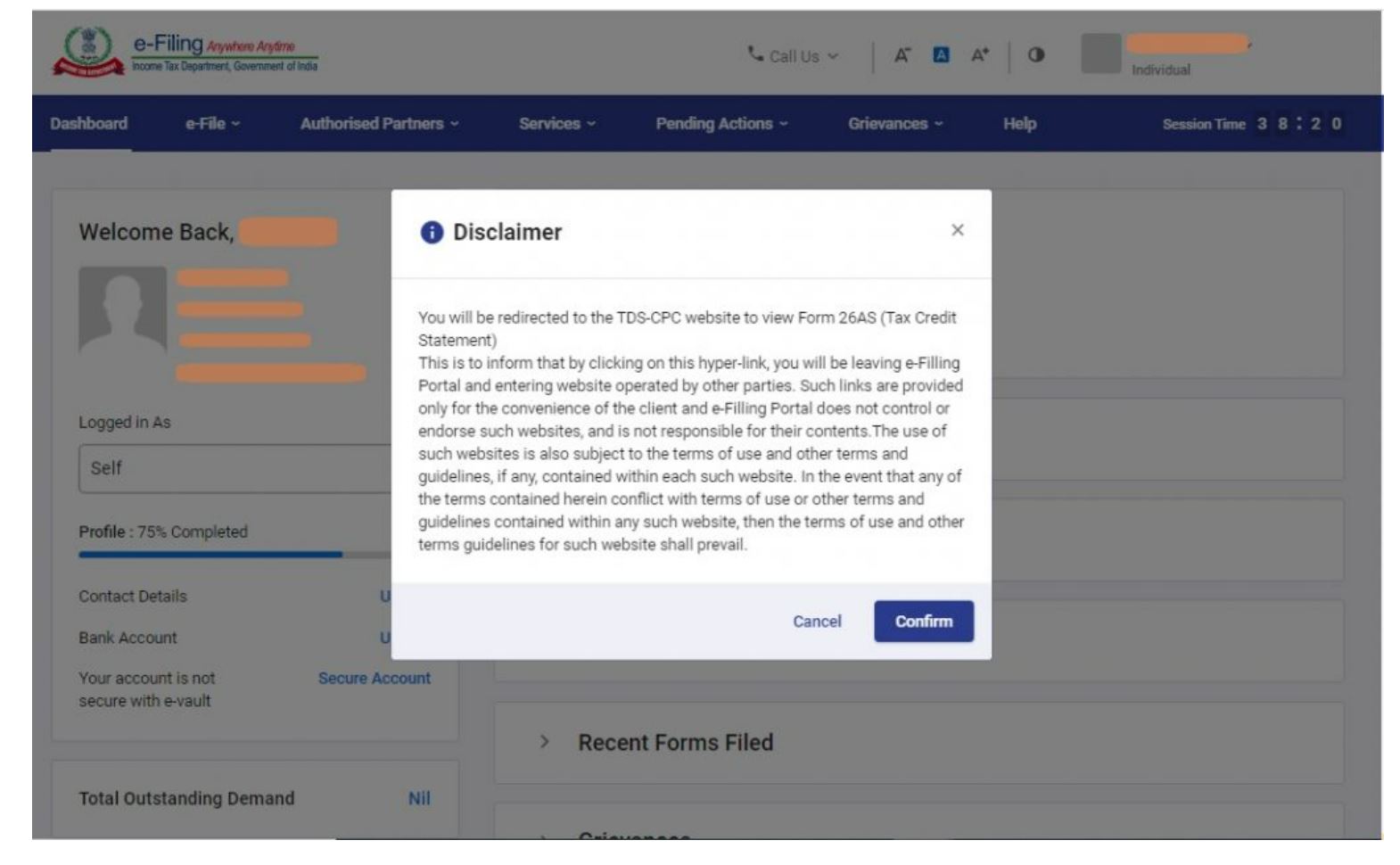
- Select the Box to Proceed
On the TRACES website, select the box visible on the screen and click on ‘Proceed’.
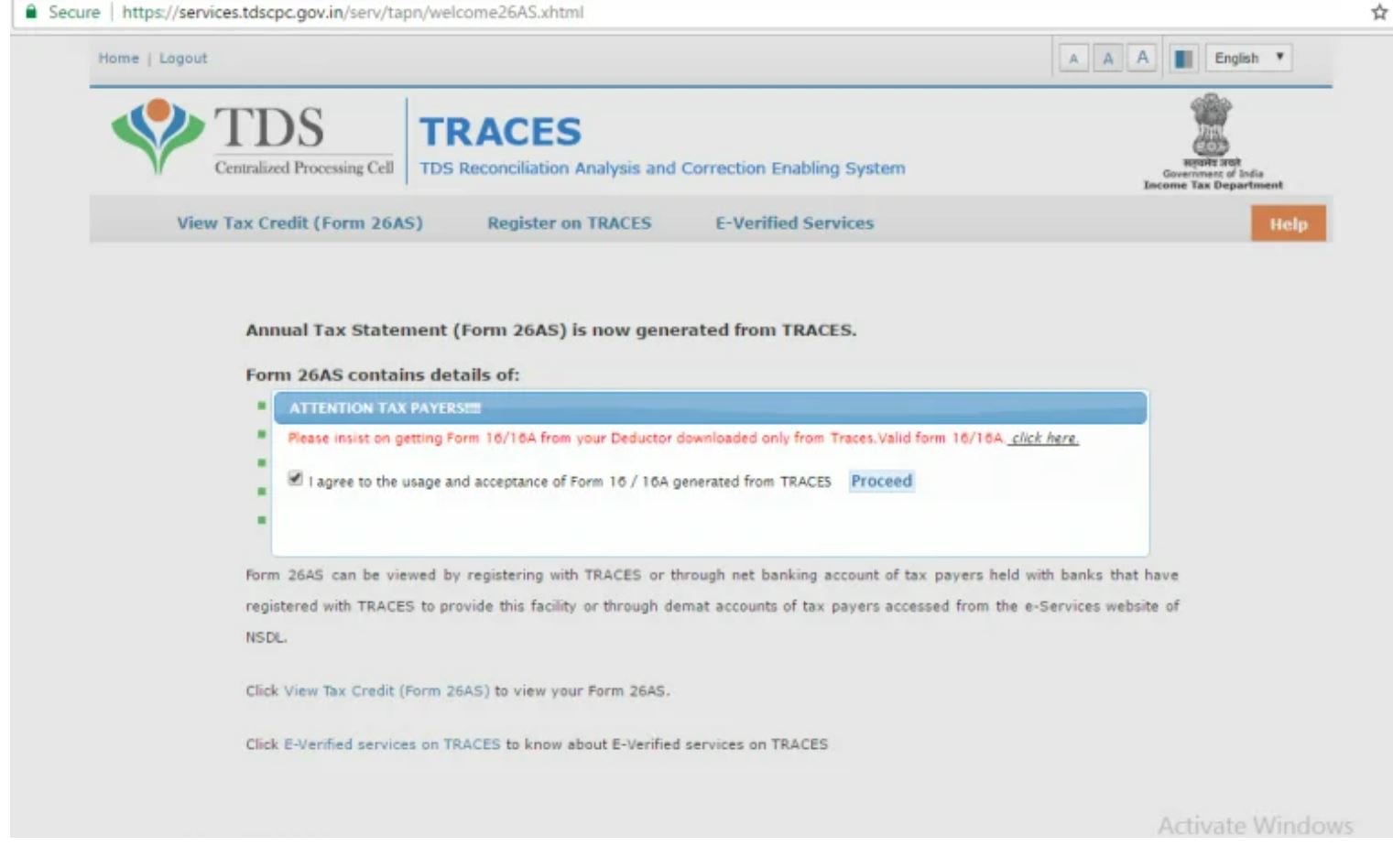
- Click ‘View Tax Credit (Form 26AS)’
You will be able to see a link at the bottom of the page – ‘View Tax Credit (Form 26AS)’. Click on it to view your Form 26AS.
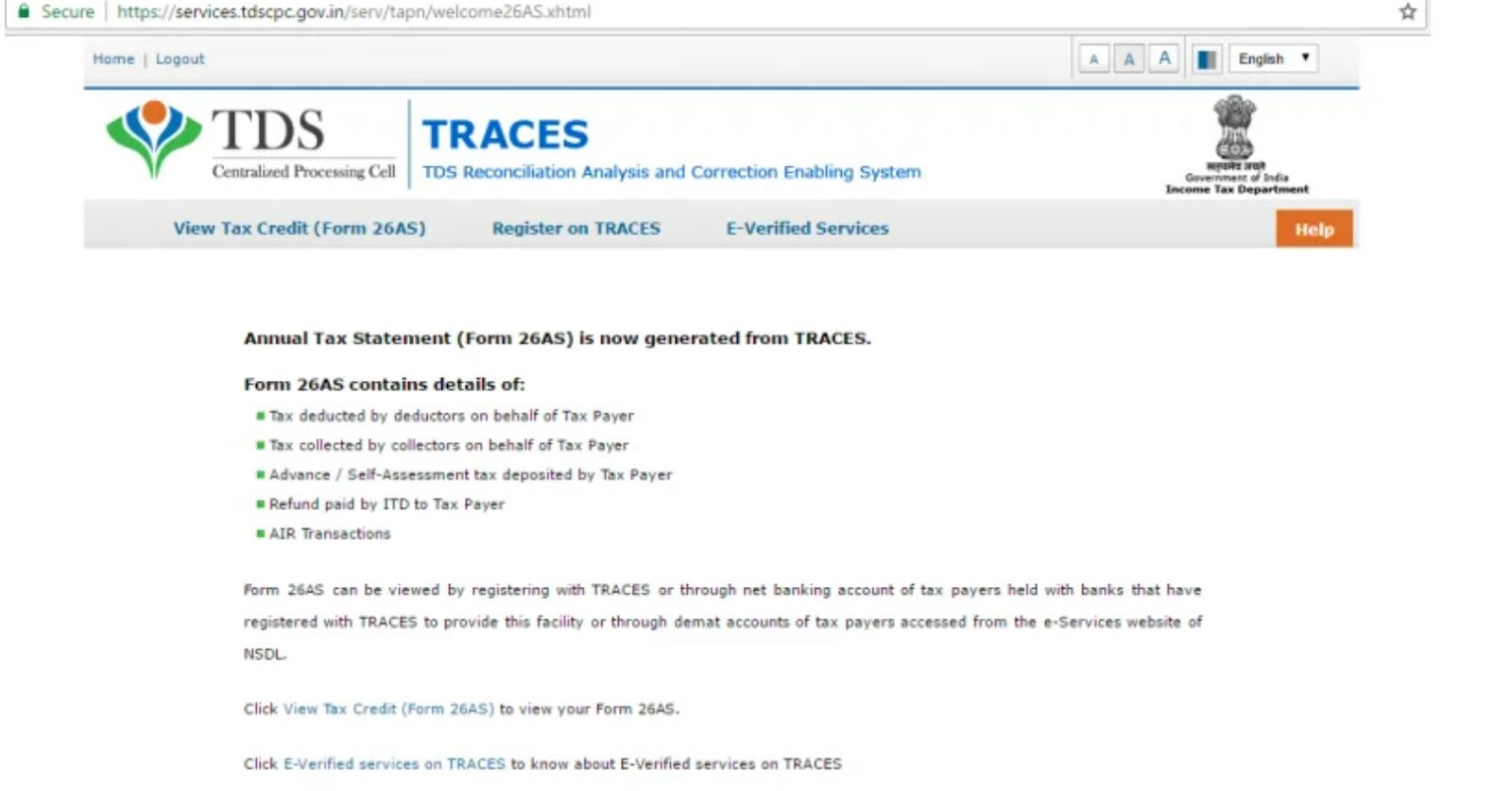
- Download Form 26AS
Select the assessment year and format you would prefer to check Form 26AS. You can either choose to see your form 26AS online in HTML format or download it in pdf format. Enter the ‘Verification Code’ and click on the ‘View/Download’ button.

Once downloaded, you will be able to view Form 26AS.
Alternatively, you can use the net banking facility to download your form 26AS. Here are the steps.
Via Net-Banking Facility
Follow the Form 26AS download process below using the net-banking facility:
Step 1: Log into your net banking account.
Step 2: Find the Tax tab from the portal of the concerned financial institution where these services usually remain available. From there, you can easily view your tax credit statement and download it.
In the downloaded document, you can check whether both your TDS and TCS statements are correctly filled or not.
Also Read
How to View Form 26AS?
You have to follow exactly the same as the Form 26AS download process to view Form 26AS. Here are a few ways you can check Form 26AS online.
- You can view Form 26AS on the TRACES portal by following the steps given above.
- Alternatively, you can view Form 26AS through the net banking facility of your bank account. Any PAN holder having an account with an authorised bank can get access to this facility.
Here is a list of authorised banks that lets you check and download form 26AS:
List of banks registered with NSDL, that provides a view of Tax Credit Statement (Form 26AS), are as below:
- Axis Bank Limited
- Bank of India
- Bank of Maharashtra
- Bank of Baroda
- Citibank N.A.
- Corporation Bank
- City Union Bank Limited
- ICICI Bank Limited
- IDBI Bank Limited
- Indian Overseas Bank
- Kotak Mahindra Bank Limited
- Indian Bank
- Karnataka Bank
- Oriental Bank of Commerce
- State Bank of India
- State Bank of Mysore
- State Bank of Travancore
- State Bank of Patiala
- The Federal Bank Limited
- The Saraswat Co-operative Bank Limited
- UCO Bank
- Union Bank
Different Components of Form 26AS
It is important to check if the data regarding tax deducted at source, as shown by the IT Department, is accurate before filing your ITR. In order to do that, you must go through the tax credit statement, which comprises the following:
1. Part A
It deals with TDS or Tax Deducted at Source. Part A is subdivided into PartA1, which deals with no or low tax deducted from Form 15G/15H. Part A2 deals with TDS from the sale of immovable property for the seller.
2. Part B
It deals with TCS or Tax Collected at Source.
3. Part C
This part deals with information on advance tax and self-assessment tax paid.
4. Part D
This part details regarding income tax refunds in a financial year such as ITR, 26QB, TAN, etc.
5. Part E
This part details the purchase of property, mutual funds, bonds, etc.
6. Part F
This part details the TDS for the sale of immovable property for the buyer and the TDS on rent for tenants.
7. Part G
This section deals with TDS defaults.
Why is Form 26AS Important?
Form 26AS helps compute your income and verify your tax credits before filing for tax returns. It helps check if the tax collected or deducted by the collector or deductor has been deposited on time. It also helps taxpayers accurately file their Income Tax Returns (ITR) as it provides a consolidated view of all tax-related transactions during the financial year. Additionally, If any excess taxes are paid, it is reflected in Form 26AS, and the taxpayer can claim a refund for the same.
How to Submit Form 26AS?
Once you visit the TRACES website you can submit your form by following these steps:
Step 1: Click on “Request for 26A/27BA” which can be found under the ‘Statement /Payment’ section.
Step 2: The guidelines to submit your form 26A/27BA online will be then visible to you, then click on ‘Proceed’
Step 3: You will have to select the Form Type, Financial Year and the Transaction Type from the drop-down menu. Click on ‘Proceed’.
Step 4: A request number will be generated as per your request for the Form. You will have to click on ‘Go to track request for 26A/27BA’.
Step 5: Your request for Form 26A/26BA will be visible to you on your screen and if you have raised a request for Non-deduction or Collection then an option to upload the file will appear.
Step 6: You will then have to ‘Click on Requested Download’ under the Download option and proceed to download the utility form.
Step 7: You will have to enter the verification code and click on the ‘Submit button.’
Step 8: You can download the TRACES Sample for Non-deduction or Non-Collection along with the utility.
Step 9: The downloaded files will be in Zip format after which we will have to extract the files and add the relevant records.
Step 10: After extracting the files from the utility it has to be run through the Java application to get them validated.
Step 11: You will find the ‘Upload Files’ option under the status for Non-Deduction/Non-Collection, click on it and enter the verification code.
Step 12: After clicking on the upload option you will have to enter a digital signature and I-PIN if redirected from the bank’s website to fulfil the verification process.
Step 13: After getting a confirmation from TRACES on successful verification you can click on ‘Go to Track Request for 26A/27BA’ and the status will be ‘Submitted’.
Step 14: After the successful validation of the request it will be sent for ‘E-filing’ after which the status will also change to ‘E-filing’.
Points to Remember
- Form 26AS is linked to your PAN.
- Form 26AS can only be downloaded by PAN holders from the TRACES portal.
- Form 26AS is generated annually.
- Form 26AS is generated when a tax transaction takes place.
Final Word
Now that there are more financial details of the assessee available in Form 26AS, it has become easier to detect any kind of discrepancy in the system. Check TCS and TDS instantly by downloading Form 26AS.
Looking for an efficient tax saving option? Invest in Navi Mutual Fund’s ELSS Tax Saver Nifty 50 Index Fund and claim tax deduction benefits of up to ₹1.5 lakh. Download the Navi app to start investing!
FAQs on Form 26AS
You can view Form 26AS online without registration through net banking.
To rectify the error(s) in Form 26AS, your deductor can file a TDS correction statement to the Income Tax department. Or, you can upload a statement explaining the reason for the mismatch in information when a query is raised by the income tax department.
Yes, Form 26AS can be downloaded in PDF format from the TRACES website and will remain password protected. To open that file, enter the password that consists of the taxpayer’s date of incorporation/DOB in DDMMYYYY format.
It will take 7 days for TDS to reflect in Form 26AS.
In case you see that some of the entries in your Form 26AS are not applicable to you, it is necessary to notify the deductor/collector regarding this immediately. You can also inform your assessing officer stating the same to fix the issue.
You can easily update your PAN details by submitting an application using the ‘Request for new PAN card/ changes or correction in PAN data.’ Use the TIN website in this regard for updating your PAN details.
Transaction date mainly refers to the date of credit or payment (whichever is earlier). Whereas date of booking refers to that particular date on which TDS return is successfully processed, and the booking of the amount in Form 26AS is completed.
TDS gets reflected in the tax credit statement once the Centralized Processing Centre or CPC processes the TDS return after the taxpayer files it. Generally, it takes 7 days for the CPC to process TDS returns.
Disclaimer
This article is solely for educational purposes. Navi doesn't take any responsibility for the information or claims made in the blog.
Read More on Income Tax Act

What is Form 26QB for TDS? How to Download and Submit it?
While purchasing a property, buyers are liable to pay various taxes. The Finance Act, 2013 made TDS... Read More »PF Withdrawal Rules 2023 – Rules, Documents Required and Types
EPF/PF Withdrawal Employees’ Provident Fund (abbreviated as EPF) is a popular retirement sav... Read More »Stamp Duty and Property Registration Charges in Delhi 2023
It is compulsory for property buyers in the Capital to pay stamp duty in Delhi during property regi... Read More »Income Tax Return – Documents, Forms and How to File ITR Online AY 2023-24
In India, it is mandatory for all taxpayers who earn more than the basic tax exemption limit to fil... Read More »What is Section 80CCD – Deductions for National Pension Scheme and Atal Pension Yojana
The Income Tax Act provides a number of deductions and tax benefits to taxpayers, so they can strat... Read More »Tax on Dividend Income: Sources, Tax Rate and TDS on dividend income
What are Dividends? Companies may raise funds for running their operations by selling equity. Th... Read More »Section 112A of Income Tax Act: Taxation on Long-Term Capital Gains
What is Section 112A? Section 112A of the Income Tax Act was announced in Budget 2018 to replace... Read More »Section 206AB of Income Tax Act: Eligibility And TDS Rate
Section 206AB was introduced in the Finance Bill 2021 as a new provision pertaining to higher deduc... Read More »What is a Credit Note in GST – Example, Format and Steps
A GST Credit Note is mandatory for any GST-registered supplier of goods or services. As a supplier,... Read More »Exemptions and Deductions Under Section 10 of Income Tax Act
What Is Section 10 of the Income Tax Act? Section 10 of the Income Tax Act, 1961 provides tax-sa... Read More »Section 57 of the Income-tax Act – Income from Other Sources
It is quite likely that many entities - individuals as well as businesses - have multiple sources o... Read More »What is Dearness Allowance? – Types, Calculation, and Current Rate
What is Dearness Allowance? Dearness Allowance Meaning - Dearness Allowance (DA) is an allowance... Read More »Top 10 Chit Fund Schemes in India in 2023
Chit funds are one of the most popular return-generating saving schemes in India. It is a financial... Read More »10 Best Gold ETFs in India to Invest in April 2023
Gold ETFs or Gold Exchange Traded Funds are passively managed funds that track the price of physica... Read More »10 Best Demat Accounts in India for Beginners in 2023
Creation of Demat accounts revolutionised the way trades were conducted at the stock exchanges. It... Read More »20 Best Index Funds to Invest in India in April 2023
What is an Index Fund? An index fund is a type of mutual fund or exchange-traded fund (ETF) that... Read More »Best Arbitrage Mutual Funds to Invest in India in April 2023
Arbitrage funds are hybrid mutual fund schemes that aim to make low-risk profits by buying and sell... Read More »10 Best SIP Plans in India to Invest in April 2023
What is SIP? SIP or Systematic Investment Plan is a method of investing a fixed amount in ... Read More »10 Best Corporate Bond Funds in India to Invest in April 2023
Corporate bond funds are debt funds that invest at least 80% of the investment corpus in companies ... Read More »10 Best Bank for Savings Account in India [Highest Interest Rate 2023]
Savings account is a type of financial instrument offered by several banks. It lets you safely depo... Read More »

